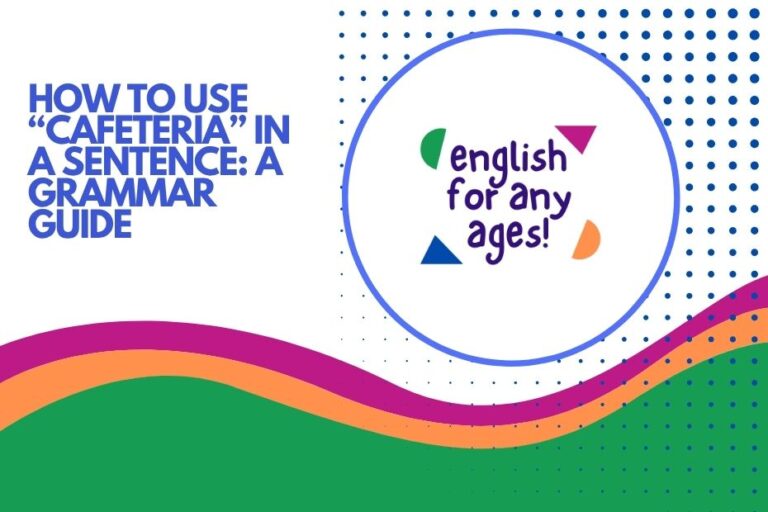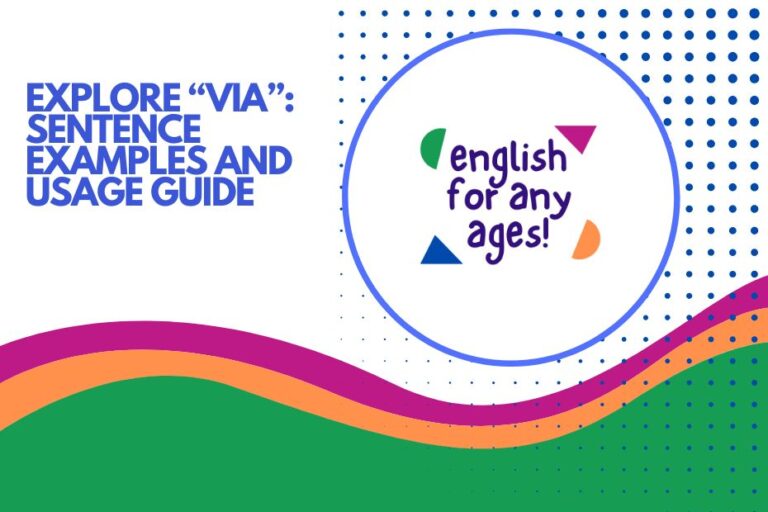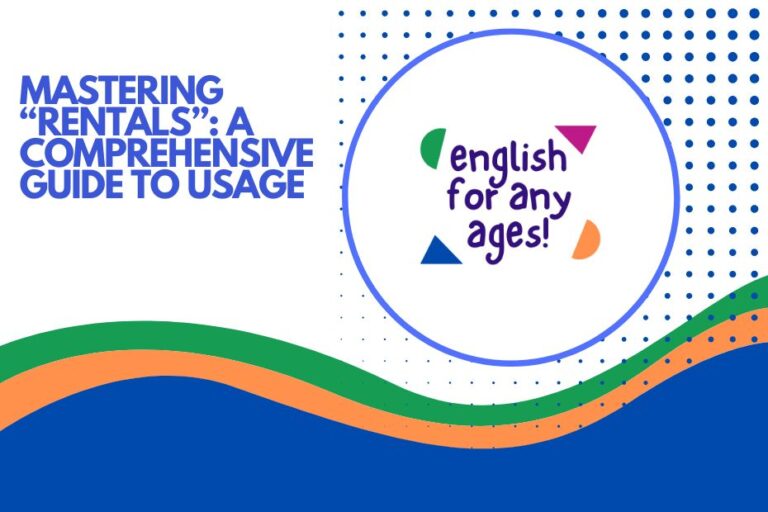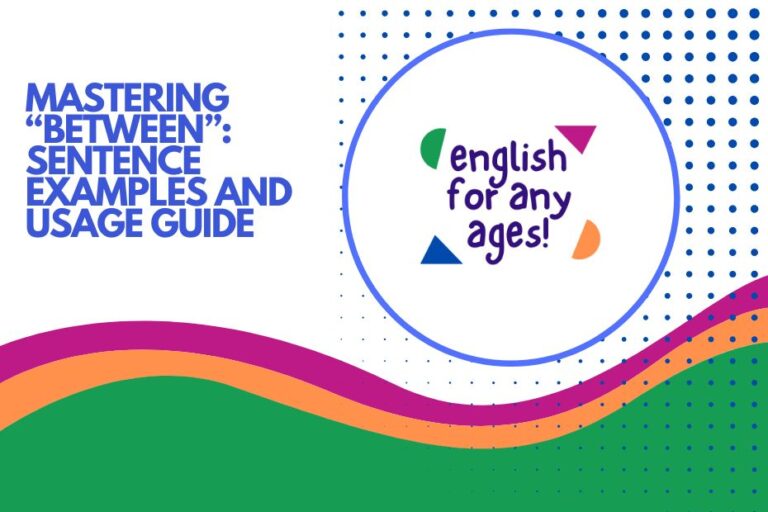Mastering “Against”: Sentence Examples and Usage Guide
The preposition “against” is a versatile word in the English language, carrying a range of meanings from opposition to physical contact. Understanding its nuances is crucial for clear and effective communication.
This article provides a comprehensive guide to using “against” correctly, covering its various meanings, grammatical structures, and common pitfalls. Whether you’re a student learning English or a seasoned writer looking to refine your skills, this guide will equip you with the knowledge and practice you need to master the preposition “against.”
This guide is designed for learners of all levels who want to improve their understanding and usage of the preposition “against.” By exploring its different meanings and applications through detailed explanations, examples, and practice exercises, you’ll gain the confidence to use “against” accurately and effectively in your writing and speaking.
Table of Contents
- Definition of “Against”
- Structural Breakdown
- Types and Categories of “Against” Usage
- Examples of “Against” in Sentences
- Usage Rules for “Against”
- Common Mistakes with “Against”
- Practice Exercises
- Advanced Topics
- Frequently Asked Questions
- Conclusion
Definition of “Against”
“Against” is a preposition that primarily indicates opposition, contact, or contrast. It is a fundamental part of English grammar, used to show relationships between nouns, pronouns, and other parts of a sentence.
Understanding its various uses is crucial for constructing grammatically correct and meaningful sentences. “Against” can specify a physical position, a conflicting opinion, or a protective measure.
As a preposition, “against” always requires an object, which can be a noun, pronoun, or noun phrase. This object follows the preposition and completes its meaning within the sentence.
The specific meaning of “against” is heavily influenced by the context of the sentence and the words it interacts with. For instance, “leaning against the wall” has a different connotation than “arguing against the proposal.”
Structural Breakdown
The basic structure of a sentence using “against” is: Subject + Verb + against + Object. The object can be a simple noun, a pronoun, or a more complex noun phrase. The prepositional phrase (“against” + object) typically functions as an adverbial modifier, providing additional information about the verb or the sentence as a whole. Understanding this structure is key to building correct and meaningful sentences.
The placement of the prepositional phrase can sometimes vary depending on the desired emphasis or sentence structure. While it usually follows the verb, it can occasionally appear at the beginning of the sentence for stylistic effect.
However, this is less common and should be used carefully to avoid ambiguity. For example, instead of saying “He argued against the decision,” you could say, “Against the decision, he argued,” but the first phrasing is more natural.
Types and Categories of “Against” Usage
The preposition “against” has several different usages, each with its own specific meaning and context. These can be broadly categorized as follows:
Opposition and Resistance
This is one of the most common uses of “against,” indicating disagreement, conflict, or resistance to something. It can refer to a person, idea, or system that is being opposed.
Examples include “He voted against the bill” and “They are fighting against injustice.” This usage often implies a struggle or a difference in opinion.
Physical Contact and Support
“Against” can also describe physical contact or support, indicating that something is touching or leaning on something else. Examples include “The ladder was leaning against the wall” and “She pressed the bandage against the wound.” This usage often implies a stable or supportive relationship between two objects.
Proximity and Background
In some cases, “against” can indicate proximity or placement in relation to a background. It suggests that something is situated near or next to something else, often for contrast or emphasis.
An example is, “The dark silhouette stood out against the bright sky,” highlighting the contrast in the scene.
Comparison and Contrast
The preposition “against” can be used to compare or contrast two things, highlighting their differences or similarities. This usage often involves measuring one thing relative to another.
For example, “His speed was measured against the world record” implies a comparison of his speed to an established standard.
Prevention and Protection
“Against” can also indicate prevention or protection from something harmful or undesirable. This usage often implies a defensive action or a safeguard.
Examples include “The vaccine protects against the virus” and “They built a wall against the flood.” This usage highlights the role of a barrier or defense mechanism.
Examples of “Against” in Sentences
To further illustrate the different usages of “against,” here are several examples organized by category:
Opposition and Resistance Examples
The following table provides examples of “against” used to indicate opposition or resistance. It showcases how “against” is used when there is a disagreement or conflict.
| Sentence | Explanation |
|---|---|
| He argued against the proposal. | He expressed his disagreement with the proposal. |
| She voted against the new law. | She opposed the new law by voting against it. |
| They are protesting against the government’s policies. | They are publicly demonstrating their opposition to the policies. |
| The lawyer argued against the prosecution’s case. | The lawyer presented arguments to counter the prosecution’s case. |
| Many people are against the war. | Many people disapprove of the war. |
| The union is fighting against unfair labor practices. | The union is actively working to combat unfair practices. |
| The community rallied against the proposed development. | The community united to oppose the development plans. |
| The athlete competed against the best in the world. | The athlete faced strong competition from top athletes. |
| The company is struggling against economic headwinds. | The company is facing difficulties due to unfavorable economic conditions. |
| The doctor advised him against smoking. | The doctor strongly recommended that he not smoke. |
| The data argues against your hypothesis. | The data does not support your hypothesis. |
| Public opinion is strongly against the measure. | The majority of the public disapproves of the measure. |
| He set his will against the odds and succeeded. | He persevered despite the challenges and achieved his goal. |
| She rebelled against the strict rules of her upbringing. | She defied the rigid rules she grew up with. |
| We must stand against injustice wherever we find it. | We must oppose injustice in all its forms. |
| The small business is competing against large corporations. | The small business is facing tough competition from bigger companies. |
| The scientist presented evidence against the theory. | The scientist offered proof that contradicted the theory. |
| The politician spoke out against corruption. | The politician publicly condemned corruption. |
| The software protects against malware. | The software defends the system against harmful software. |
| The team fought valiantly against a stronger opponent. | The team displayed great courage in facing a superior team. |
| The patient is battling against a serious illness. | The patient is struggling to overcome a severe disease. |
| The author wrote a book against social inequality. | The author used the book to advocate for equality. |
| The community organized against the construction of the factory. | The community opposed the factory’s construction through organized efforts. |
Physical Contact and Support Examples
The following table showcases how “against” is used to describe physical contact or support. These examples illustrate situations where one object is touching or leaning on another.
| Sentence | Explanation |
|---|---|
| The ladder was leaning against the wall. | The ladder was positioned at an angle, supported by the wall. |
| She pressed the bandage against the wound. | She applied the bandage directly to the wound. |
| He leaned his bike against the tree. | He propped up his bike so it was supported by the tree. |
| The picture was hung against the blue wallpaper. | The picture was placed on the blue wallpaper. |
| The child snuggled against his mother. | The child cuddled close to his mother. |
| The boat crashed against the rocks. | The boat collided forcefully with the rocks. |
| The rain was pelting against the windows. | The rain was hitting the windows hard. |
| He braced himself against the wind. | He prepared his body to resist the force of the wind. |
| The shelf was flush against the wall. | The shelf was perfectly aligned with the wall. |
| The waves crashed against the shore. | The waves powerfully hit the coastline. |
| She held the phone tightly against her ear. | She kept the phone pressed close to her ear. |
| The poster was glued against the bulletin board. | The poster was attached to the bulletin board with glue. |
| He rested his head against the headrest. | He leaned his head back on the headrest for support. |
| The climber secured the rope against the rock face. | The climber fastened the rope to the rock for safety. |
| The car skidded against the guardrail. | The car slid and made contact with the guardrail. |
| She shielded her eyes against the bright sun. | She used her hand to block the sun from her eyes. |
| The painting was displayed against a neutral backdrop. | The painting was shown with a plain background to enhance its features. |
| He leaned his forehead against the cool glass. | He rested his forehead on the glass to feel its coolness. |
| The book was propped against the stack of papers. | The book was supported by the pile of papers. |
| The construction workers reinforced the foundation against the earthquake. | The construction workers strengthened the foundation to withstand the earthquake. |
| The child hid against the wardrobe in the dark. | The child sought refuge behind the wardrobe in the darkness. |
| The sculpture was placed against the backdrop of the cityscape. | The sculpture was positioned with the city skyline as its background. |
Proximity and Background Examples
This table illustrates how “against” is used to show proximity or placement in relation to a background. These examples highlight how something is situated near or next to something else, often for contrast or emphasis.
| Sentence | Explanation |
|---|---|
| The dark silhouette stood out against the bright sky. | The dark shape was easily visible due to the contrasting bright background. |
| The white flowers looked beautiful against the green foliage. | The white flowers were visually appealing because of the green background. |
| The old house looked stark against the modern buildings. | The old house contrasted sharply with the newer buildings around it. |
| The artist painted a portrait against a plain background. | The portrait was set against a simple background to focus attention on the subject. |
| The model posed against the brick wall. | The model stood in front of the brick wall for a photo. |
| The graffiti stood out against the clean surface. | The graffiti was noticeable due to the contrast with the clean wall. |
| The lighthouse shone brightly against the dark horizon. | The lighthouse was easily seen because of the dark background. |
| The colorful mural was painted against the gray building. | The mural stood out because of the contrast with the gray building. |
| The statue was placed against the backdrop of the mountains. | The statue had the mountains as a scenic background. |
| The text was displayed against a black background. | The text was easier to read because of the dark background. |
| The moon appeared small against the vastness of space. | The moon seemed tiny compared to the size of space. |
| The single tree stood against the empty field. | The tree was isolated and noticeable in the open field. |
| The climber looked tiny against the huge mountain. | The climber seemed small in comparison to the mountain’s size. |
| The old photograph looked faded against the new ones. | The old photograph seemed worn compared to the newer ones. |
| The jewelry sparkled against the velvet cloth. | The jewelry’s shine was enhanced by the soft velvet. |
| The website displayed the logo against a minimalist design. | The website featured the logo with a simple background. |
| The actor played the scene against an emotional score. | The actor performed the scene with music that heightened the emotion. |
| The presentation used data against industry benchmarks. | The presentation compared the data to standards in the industry. |
| The writer set the novel against the backdrop of war. | The writer used the war as the setting for the story. |
Comparison and Contrast Examples
The following table illustrates how “against” is used to compare or contrast two things, highlighting their differences or similarities. This usage often involves measuring one thing relative to another.
| Sentence | Explanation |
|---|---|
| His speed was measured against the world record. | His speed was compared to the current world record for that sport. |
| The company’s profits were compared against last year’s earnings. | The company’s profits were evaluated relative to the previous year’s performance. |
| Her performance was judged against her previous best. | Her current performance was assessed in relation to her personal best. |
| The new product was tested against existing market standards. | The new product was evaluated based on established market benchmarks. |
| The student’s progress was assessed against the curriculum goals. | The student’s development was measured against the learning objectives. |
| The project’s success was evaluated against the initial objectives. | The project’s outcome was compared to the original goals. |
| The athlete’s time was compared against the Olympic standard. | The athlete’s time was measured against the qualifying time for the Olympics. |
| The candidate’s qualifications were judged against the job requirements. | The candidate’s skills and experience were assessed to see if they matched the job description. |
| The building’s energy efficiency was measured against industry averages. | The building’s energy use was compared to the average energy consumption of similar buildings. |
| The new policy was evaluated against ethical guidelines. | The policy was assessed to ensure it aligned with ethical principles. |
| The research findings were analyzed against existing literature. | The research results were compared to previously published studies. |
| The software’s performance was benchmarked against competitor products. | The software’s effectiveness was compared to the performance of similar software. |
| The teacher graded the essay against a rubric. | The teacher used a set of criteria to evaluate the essay. |
| They weighed the pros against the cons before making a decision. | They considered the advantages and disadvantages before deciding. |
| The cost was measured against the benefits. | The price was compared to the advantages gained. |
| The risks were assessed against the potential rewards. | The possible dangers were weighed against the possible gains. |
| The employee’s performance was reviewed against their job description. | The employee’s work was compared to the expectations of their role. |
| The country’s progress was measured against the UN’s sustainable development goals. | The country’s advancement was assessed in relation to the global goals. |
Prevention and Protection Examples
This table provides examples of “against” used to indicate prevention or protection from something harmful or undesirable. This usage often implies a defensive action or a safeguard.
| Sentence | Explanation |
|---|---|
| The vaccine protects against the virus. | The vaccine provides immunity from the virus. |
| They built a wall against the flood. | They constructed a barrier to prevent flooding. |
| Sunscreen protects your skin against sunburn. | Sunscreen prevents your skin from being burned by the sun. |
| The insurance policy protects against financial loss. | The insurance policy provides coverage for financial losses. |
| The company implemented security measures against cyber attacks. | The company took steps to prevent cyber attacks. |
| The law provides protection against discrimination. | The law safeguards people from being discriminated against. |
| Wearing a helmet protects against head injuries. | A helmet prevents injuries to the head. |
| The country has defenses against invasion. | The country has systems in place to prevent being invaded. |
| The firewall protects the computer against unauthorized access. | The firewall prevents unauthorized people from accessing the computer. |
| The treaty provides safeguards against war. | The treaty includes measures to prevent war. |
| The buffer state acted as a shield against larger powers. | The buffer state provided protection from larger, more powerful countries. |
| The company hedged its bets against market volatility. | The company took steps to reduce the risk from market swings. |
| The government issued a warning against fraudulent schemes. | The government cautioned people about scams. |
| The medication provides relief against allergy symptoms. | The medication alleviates the symptoms of allergies. |
| The training prepared them against unexpected challenges. | The training readied them to face unforeseen difficulties. |
| The contract includes clauses against breach of agreement. | The contract has provisions to prevent violations of the agreement. |
| The regulations protect consumers against deceptive advertising. | The regulations shield consumers from misleading ads. |
| The seatbelts protect passengers against injury during accidents. | The seatbelts reduce the likelihood of injury in a car crash. |
| The community is working to build resilience against climate change. | The community is striving to withstand the effects of climate change. |
Usage Rules for “Against”
While “against” is a versatile preposition, there are specific rules to follow for its correct usage. These rules ensure clarity and accuracy in your writing and speech.
Always consider the context of the sentence to determine the most appropriate meaning of “against.”
One important rule is to ensure that “against” is followed by a valid object. This object must be a noun, pronoun, or noun phrase that completes the meaning of the preposition.
For instance, “He leaned against” is incomplete without an object, such as “He leaned against the wall.” Also, be mindful of the specific meaning you intend to convey, as using “against” in the wrong context can lead to confusion. For example, while “He is against the idea” is correct, saying “He is against the wall” when you mean “He is near the wall” would be incorrect.
Common Mistakes with “Against”
Even experienced English speakers sometimes make mistakes with the preposition “against.” Being aware of these common errors can help you avoid them in your own writing and speech.
One frequent mistake is confusing “against” with other prepositions like “near” or “next to.” While “against” can sometimes indicate proximity, it always implies contact or opposition. For example, saying “The house is against the river” when you mean “The house is near the river” is incorrect.
Another common error is using “against” when “for” is more appropriate. For instance, “He argued against the proposal” is correct if he opposes it, but “He argued for the proposal” is correct if he supports it.
Here are some examples of common mistakes and their corrections:
| Incorrect | Correct | Explanation |
|---|---|---|
| He is against the wall. | He is near the wall. / He is leaning against the wall. | “Against” implies contact, so use “near” if you mean proximity without contact. |
| She argued against the idea, so she supported it. | She argued for the idea, so she supported it. | “Against” means opposition, while “for” means support. |
| The boat sailed against the storm, safely. | The boat sailed through the storm, safely. | “Against” implies resistance, while “through” implies navigating. |
| They protected the city against the threat. | They protected the city from the threat. | “From” is often used to indicate protection from a threat. |
Practice Exercises
Test your understanding of “against” with these practice exercises. Fill in the blanks with the correct use of “against” based on the context of each sentence.
Exercise 1: Fill in the blanks with “against.”
| Question | Answer |
|---|---|
| 1. He leaned the ladder ______ the building. | against |
| 2. She voted ______ the proposal. | against |
| 3. The waves crashed ______ the shore. | against |
| 4. The vaccine protects ______ the flu. | against |
| 5. The dark clouds stood out ______ the blue sky. | against |
| 6. They are fighting ______ injustice. | against |
| 7. The company is struggling ______ economic difficulties. | against |
| 8. He braced himself ______ the strong wind. | against |
| 9. The lawyer argued ______ the evidence. | against |
| 10. The new policy was tested ______ industry standards. | against |
Exercise 2: Choose the correct preposition (“against” or “for”) in each sentence.
| Question | Answer |
|---|---|
| 1. He argued (against/for) the new policy because he believed it was unfair. | against |
| 2. She spoke (against/for) the proposal, highlighting its benefits. | for |
| 3. They are campaigning (against/for) stricter environmental regulations. | for |
| 4. The community rallied (against/for) the construction of the new highway. | against |
| 5. The politician advocated (against/for) tax cuts for small businesses. | for |
| 6. The scientist presented evidence (against/for) the existence of the phenomenon. | for |
| 7. The students protested (against/for) the increase in tuition fees. | against |
| 8. The organization is working (against/for) the eradication of poverty. | for |
| 9. The athlete trained (against/for) the upcoming competition. | for |
| 10. The doctor advised him (against/for) eating too much sugar. | against |
Exercise 3: Rewrite the following sentences using “against” in a meaningful way.
| Question | Answer |
|---|---|
| 1. The company is struggling with tough economic conditions. | The company is struggling against tough economic conditions. |
| 2. They built a wall to protect the city from flooding. | They built a wall against the flood to protect the city. |
| 3. He leaned on the tree for support. | He leaned against the tree for support. |
| 4. Her performance was compared to her previous record. | Her performance was measured against her previous record. |
| 5. The dark silhouette stood out because of the bright sky. | The dark silhouette stood out against the bright sky. |
| 6. She expressed her disagreement with the proposal. | She argued against the proposal. |
| 7. The insurance covers financial losses. | The insurance protects against financial losses. |
| 8. The new product was tested to see if it met market standards. | The new product was tested against market standards. |
| 9. He braced himself to resist the strong wind. | He braced himself against the strong wind. |
| 10. The lawyer provided arguments to counter the prosecution’s case. | The lawyer argued against the prosecution’s case. |
Advanced Topics
For advanced learners, understanding the nuances of “against” in more complex sentence structures and idiomatic expressions is essential. “Against” can be used in various idiomatic phrases, each with its unique meaning.
For example, “to be up against something” means to be facing a difficult challenge. Similarly, “to race against time” means to hurry to meet a deadline.
Furthermore, the use of “against” can vary slightly depending on the register and context. In formal writing, it’s important to use “against” precisely and avoid ambiguity.
In informal speech, the usage might be more relaxed, but clarity should still be a priority. Exploring literary texts and advanced grammar resources can provide further insights into the subtle uses of “against” in different contexts.
Frequently Asked Questions
Here are some frequently asked questions about using the preposition “against”:
- What is the primary function of the preposition “against”?
The primary function of “against” is to indicate opposition, contact, or comparison. It shows a relationship between a subject and an object, specifying resistance, physical interaction, or relative assessment.
- Can “against” be used to indicate support?
While “against” primarily indicates opposition, it can imply support in the context of physical contact, such as “leaning against a wall.” However, in terms of opinions or ideas, “against” always means opposition; “for” is used to indicate support.
- Is it correct to say “He is against the wall” if I mean he is near the wall?
No, it is not correct. “Against” implies physical contact or opposition. If you mean he is simply near the wall, you should say “He is near the wall” or “He is next to the wall.”
- What is the difference between “against” and “versus”?
“Against” and “versus” are often used interchangeably to indicate opposition, especially in competitive contexts. However, “versus” is typically used in more formal settings, such as legal or sporting contexts, while “against” is more common in everyday language.
- How can I avoid common mistakes when using “against”?
To avoid mistakes, always consider the context of the sentence and the specific meaning you want to convey. Double-check that “against” is followed by a valid object and that it accurately represents the relationship between the subject and the object. Practice using “against” in different contexts to improve your understanding.
- Can “against” be used at the beginning of a sentence?
While it’s less common, “against” can be used at the beginning of a sentence for stylistic effect or emphasis. For example, “Against all odds, he succeeded.” However, ensure that the sentence remains clear and grammatically correct.
- What are some common idiomatic expressions using “against”?
Some common idiomatic expressions using “against” include “to be up against something” (facing a difficult challenge), “to race against time” (hurrying to meet a deadline), and “to go against the grain” (acting contrary to the norm).
- How does the usage of “against” differ in formal vs. informal contexts?
In formal contexts, the usage of “against” should be precise and unambiguous. In informal contexts, the usage might be more relaxed, but clarity should still be a priority. Avoid slang or colloquial expressions that misuse “against.”
Conclusion
Mastering the preposition “against” is essential for clear and effective communication in English. By understanding its various meanings, structural rules, and common pitfalls, you can use “against” with confidence and accuracy.
This guide has provided a comprehensive overview of “against,” covering its different usages, providing numerous examples, and offering practice exercises to reinforce your learning.
Remember to always consider the context of the sentence and the specific meaning you want






